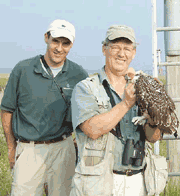Flight of the Osprey
How the hardest working bird on the Bay goes south
by Dotty Holcomb Doherty
Their mother abandoned them mid-August. She left these children as she had her others, six times before, though their fishing forays still were unsuccessful. It was time.
Her job was over. She had warmed her twins, a son and daughter, as they lay curled in dun-colored eggs; fed them until they could feed themselves. She sheltered them from storms that blew across the Bay; shaded them with outstretched wings from the hot Chesapeake sun.
As days shortened, her blood stirred though the summer heat remained. She rose into the early morning sky, called to her family and left. She would never see her offspring again.
A Mother’s Story
Hatched on a May morning 11 years ago, she, like her young, had grown strong on menhaden and striped bass flown in by her father, a good provider. Two siblings never hatched; another survived with her. Anxious to fly, they flapped their lengthening wings each day, talons still tightly gripping the long branches of the nest. Two months after first seeing the sky, she joined it, soaring toward danger and freedom.
She left the Bay alone, following a genetic instinct to head south. Down the coast, leaping from North Carolina to Florida, then island-hopping from Cuba to Hispaniola, she finally landed in Columbia. Here she would stay on her wintering grounds for three years, with fish plentiful and temperatures warm.
Her migratory instinct revived in her fourth spring, pushing her to the Bay of her birth. She chose a mate whose nest was large, whose aerial displays impressed her. They’ve been raising chicks together ever since, returning to their nest each March after wintering separately.
The Twins’ First Flight
This year’s daughter caught her first fish two weeks after her mother left. The father, still providing for the twins, lingered one more week. Independence was imminent.
The daughter was stronger than her brother. First to hatch, first to fledge, first to catch a fish. She soared away from the nest on September 17, pulled south like the monarch butterflies below her. She spent that night near Norfolk, Virginia, then flew 106 miles to Pamlico Sound, fishing for a day with other migrating ospreys near Swanquarter, North Carolina.
From here, most ospreys will head south to Cape Fear, where the coastline dips west. A few will follow the coast to Florida, but most, like her mother, take a direct route over the ocean, arriving in Florida after an overnight, 20-hour flight, before heading on to Cuba. The daughter did neither.
She left Swanquarter heading southeast, toward the east end of the Bahamas, 1,000 miles away. A gusting westerly wind combined with a faulty genetic compass took her over the Atlantic with nowhere to land. Her strength kept her going for 30 hours, as she averaged 27 mph, gliding more than flapping. Finally, after 800 miles, the exhausted young bird fell into the sea.
Her brother carried his father’s propensity for exploration. Driven by wanderlust, he headed west to the mountains of Maryland, fishing along the Potomac for two weeks. Sauntering down to the James River, he continued on to North Carolina, to the Chowan River and Albemarle Sound, then to Pamlico Sound near Swanquarter, where his sister had seen her last bit of land. As though warned, he flew west again, to Goldsboro, N.C., and the Neuse River. Then, amazingly, he again went north. Up to the Roanoke River, up to the mountains where he rode the thermals, fished in the South Fork of the Shenandoah and watched the leaves quietly blush from green to crimson and gold.
A dusting of snow in late October finally reset his compass and kick-started his instinctual need to head south. Straight to North Carolina’s Myrtle Beach, then hugging the coast, he flew across Florida to the Everglades, where he spent the next two weeks, resting from his meandering 1,600-mile journey. Perhaps he had a bit of his sister’s waywardness, for next he headed southeast toward the eastern end of Cuba, flying all night, rather than the straight southern route most ospreys take.
Though late, he was now following the path of thousands of ospreys on this highway to the tropics. Flying toward Hispaniola, he left Cuba from the port town of Santiago, where, on one record-setting day, over 600 ospreys passed through. Crossing these islands, he avoided hunters who protected fish farms or needed meat for their family’s stew, where too many ospreys before him had met their fate. Along the south coast of Hispaniola, he arrived at the southernmost peninsula, where he spent one day before his 500-mile crossing to Columbia.
Full Circle
Osprey remain faithful to the spot they find as juveniles. Many locate a spot to their liking soon after reaching South America. But this boy continued throughout the winter, from mountains to rivers, from Columbia to Venezuela, clocking an astounding 4,800 miles since leaving the Bay. But settle he did, as April, 2006, rolled in, on a lagoon in eastern Venezuela, listening to macaws and parrots, to tinamouse and hundreds of others calling from the rain forest.
His parents, back on their Chesapeake nest, had started again. You saw their flight, and the flight of their children, this year.
How this story was written
The twins are based on two ospreys monitored by satellite transmitters by the University of North Carolina, Charlotte. Erica, hatched in Delaware Seashore State Park, did not survive her first migration. Many young osprey do not. Homer began his journey on Martha’s Vineyard in 2005 and traveled 5,200 miles. Follow the Osprey Migration Study conducted by Richard O. Bierregaard, assistant professor of biology at UNC Charlotte, at www.bioweb.uncc.edu/bierregaard/Index.htm.